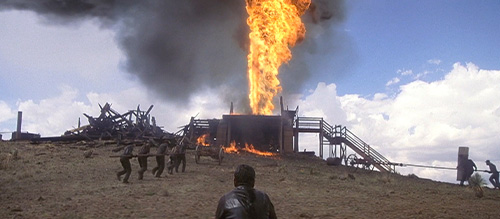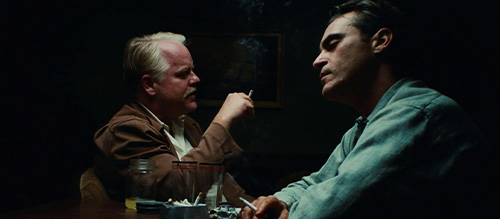Where to Start with Paul Thomas Anderson
Paul Thomas Anderson may be the best of his generation of filmmakers. His cinematic style aligns with cinephilic aesthetic sensibilities, composed of long takes and detailed production design. That design helps transport viewers across time and space, often aided by wonderful scores and soundtracks. While these elements of his films are excellent, what truly makes Anderson great is that his films tap into fundamental questions regarding human existence. Who are we? Is there something greater than ourselves? Are we capable of change? His films are about what it is to be human, and how we comport ourselves in the darkest of times. They’re approached with seriousness that isn’t humorless, equal parts entertaining, suspenseful, and profound. Character is emphasized above all, and dualities are explored without declaring one side or the other “correct.”
Anderson, like many auteurs, may be best known for the actors he has consistently worked with. Joaquin Phoenix, Daniel Day-Lewis, and Philip Seymour Hoffman have led several of his films to much critical acclaim. Actors who are not often thought of for their great dramatic work have turned in incredible performances too, such as Mark Wahlberg, Adam Sandler, and John C. Reilly. Anderson clearly has a talent for getting the best out of his performers, and working with his team to find the right person for a role. This may be his biggest strength in an industry where the on-screen talent is so often the focus of the movie-going public.
Outside of his debut Hard Eight, and the Sandler-led Punch-Drunk Love, each of his films have received attention at the Academy Awards, and his work has also earned him Best Director recognition at major film festivals – at Cannes for Punch-Drunk Love, at Berlin for There Will Be Blood, and at Venice for The Master. Magnolia also received the Golden Bear for Best Film at the Berlin International Film Festival. His industry and critical recognition puts him on a level few filmmakers reach.
It can be difficult to decide where to begin with Anderson’s filmography, so allow us here at The Film Magazine to guide you on your journey through his oeuvre. Here is Where to Start with Paul Thomas Anderson.
1. Boogie Nights (1997)

Paul Thomas Anderson’s breakthrough film brings viewers to the height of the pornographic film industry in 1970s Los Angeles. Mark Walberg leads an ensemble cast composed of Julianne Moore, Burt Reynolds, Heather Graham, John C. Reilly, Don Cheadle, Philip Seymour Hoffman, William H. Macy, and many more. Reynolds is director Jack Horner, a passionate pornographic filmmaker who genuinely wants to create good work. The rest of the cast play porn stars and crew members in Horner’s orbit who help Walberg’s well-endowed Dirk Diggler navigate the new world in which he finds himself. Boogie Nights is ultimately the story of the American dream – striking rich in the entertainment industry and achieving material gains, only to find oneself weighed down by the vices that come along with success. The story is filled with comedy and tragedy, and maintains an exceptional pace throughout.
What’s interesting about Boogie Nights is that it is as much about the film industry as the porn industry. Anderson’s camera spends more time on the equipment of 1970s filmmaking than it does on Dirk Diggler’s legendary tool. The flashing lights of Polaroids, the film and canisters used to shoot the porn, and diegetic, contemporary film shots are incorporated into Anderson’s movie. The rise of the videotape is documented, and shows how it affected the quality of cinema in every aspect. It creates a characterization of cameras that parallels the humanization of its often objectified subjects. Cinema has been a part of all of our lives for decades, and Anderson celebrates it through all of Boogie Nights’ ups and downs.
Boogie Nights is a good representation of Anderson’s early work, and shows his ability to portray and analyze the human experience without judgment.
2. There Will Be Blood (2007)

Perhaps Paul Thomas Anderson’s best work, There Will Be Blood tells the story of oil magnate Daniel Plainview and his prolonged rivalry with preacher Eli Sunday. Daniel Day-Lewis stars as Plainview in one of the most prolific performances of the great actor’s career. Day-Lewis is a dark, menacing presence with plenty of dimension to help this villainous character feel human. Paul Dano turns in an equally stunning, explosive performance as Sunday, going toe-to-toe with Day-Lewis in every scene they share. It’s tactile in its cinematic style – the heat of burning fires, the slickness of fresh oil, and Daniel Day-Lewis’ grizzled appearance can be felt through the screen.
The cinematic styling also gives this small story an epic quality, reminiscent of the work of David Lean or John Ford. The camera drinks in the landscape of the slowly urbanizing old west, and turns oil derricks into architectural idols. Flames erupt from them as if hell itself is attempting to emerge onto the earth to drag Daniel Plainview into its maw. Don’t go in expecting similar pacing to Boogie Nights, however – the film takes its time with every shot and scene, lending to the harsh, gruelling journey faced by the characters. The impressionistic aspects of sound, camera, and editing, show that realism is a means utilized by the film, and not only a great accomplishment in its own right. The authenticity and representationalism work in concert with the emotional components of the performances and story as well as the aesthetic style to bring the film to a higher level.
There are hardly any weaknesses in Anderson’s filmography, so to call There Will Be Blood his magnum opus is a testament to its position as a 21st century masterpiece.
3. The Master (2012)

What makes The Master great are the performances from its two lead actors, Joaquin Phoenix and Philip Seymour Hoffman, who play Freddie Quell and Lancaster Dodd respectively. The two share an odd, cosmic relationship. Dodd is the head of a cult called The Cause, and Freddie is an alcoholic seaman with mental health issues. Dodd feels drawn to him despite their seeming differences, but Freddie’s violent outbursts and crude nature create as many problems for the pair as Dodd’s pride and hedonism.
The Master is somewhat of an enigma of a film. It’s quite provocative and begs for interpretation, but carries no clear meaning. There are numerous influences on the story, and critics have read themes about post-World War II America, religion, and, more specifically, Scientology. The filmmaker himself may not even know. Perhaps that in itself is a goal – The Master is a Rorschach test, a journey into one’s own subconscious to search for a takeaway. There is the question of whether humans can overcome their animalistic nature, as Dodd tries to tame Freddie to bring him into the fold. The characters contrast, but each has their moments where they take on the temperament of the other.
This relationship is what drives The Master, and if you’re not sold on it then the film may be a laborious watch. It is Paul Thomas Anderson’s favorite of his films, and it deserves a watch from any cinephile for that reason alone.
Recommended for you: Paul Thomas Anderson Films Ranked
As of writing, Paul Thomas Anderson has released nine films, and there’s reason for any of them to be in this guide. It hurts to not include Phantom Thread or Punch-Drunk Love, and you really can’t go wrong checking out any of his movies.

